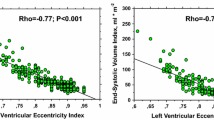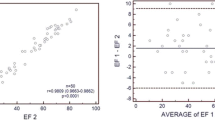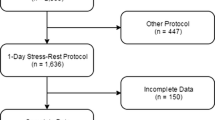Abstract
Left ventricular ejection fraction (LVEF) and single-photon emission tomographic (SPET) imaging of the myocardium can be performed after a single technetium-99m sestamibi (MIBI) injection. Sixty patients underwent SPET imaging with MIBI. Immediately after SPET acquisition ECG-gated99mTc-MIBI perfusion images were acquired using 24 planar images per R-R interval. A new method for measurement of LVEF from the ECG-gated 99mTc-MIBI perfusion images was developed. To validate the method, LVEF derived from MIBI perfusion images was compared with that from conventional radionuclide ventriculography in all 60 patients. Forty patients had evidence of myocardial infarction and 20 had normal perfusion on MIBI imaging. There was no statistically significant difference between LVEF computed from99mTc-MIBI perfusion images and that from radionuclide ventriculography (r=0.7062,P<0.001). There was little difference associated with the technique (intraobserver variabilityr=0.9772,P<0.001). Interobserver variability was also good (r-0.8233,P<0.001). LVEF from99mTc-MIBI perfusion images can be obtained at the same time as assessment of myocardial perfusion and in the same orientation and metabolism of the myocardium, thereby permitting more accurate and realistic prognosis and diagnosis in patients with coronary artery disease.
Similar content being viewed by others
References
Pryor DB, Harrel FE, Lee KL, et al. Prognostic indicators from radionuclide angiography in medically treated patients with coronary artery disease.Am J Cardiol 1984; 53: 18–22.
Veterans Administration Coronary Artery Bypass Surgery Cooperative Study Group. Eleven year survival in the Veterans Administration randomised trial of coronary bypass surgery for stable angina.N Engl J Med 1984; 311: 1333–1339.
The Multicenter Postinfarction Research Group. Risk stratification and survival after myocardial infarction.N Engl J Med 1983; 310: 331–336.
Jeffrey SB, Miller D, Theodore S, et al. Radionuclide cineangiography in acute myocardial infarction.Semin Nucl Med 1987; XVIL: 89–94.
Robert HJ. Use of radionuclide measurements of left ventricular function for prognosis in patients with coronary artery disease.Semin Nucl Med 1987; XVII: 95–105.
Steven CP. The role of radionuclide ventriculography in the assessment of prognosis in the patients with CAD.J Nucl Med 1994; 35: 721–725.
Callahan RJ, Froelich HW, McKusick KA, Leppo J, Strauss HW A modified method for in vivo labelling of red blood cells with Tc-99m: concise communication. J Nucl Med 1982; 23: 315–318.
Bland JM. Altman BG Statistical methods for assessing agreement between two methods of clinical measurement. Lancet 1986; 8: 307–310.
Verani MS, Jeroudi MO, Mahmarian JJ, et al. Quantification of myocardial infarction during coronary occlusion and myocardial salvage after reperfusion using cardiac imaging with technetium-99m hexakis-2-methoxyisobutyl isonitrile.J Am Coll Cardiol 1988; 12: 1573–1581.
Gibbons RJ, Verani MS, Behrenbeck T, et al. Feasibility of tomographic 99mTc-hexakis-2-methoxy-2-methylpropyl-isonitrile imaging for the assessment of myocardial area at risk and the effect of treatment in acute myocardial infarction.Circulation 1989; 80: 1277–1286.
Okada RD, Grover D, Gaffney T, Williams S. Myocardial kinetic of technetium-99m-hexakis-2-methoxy-2-methyl-propylisonitrile.Circulation 1988; 77: 491–498.
Schneider RM, Jaszczak RJ, Coleman RE, Cobb FR. Disproportionate effects of regional hypokinesis on radionuclide ejection fraction compensation using attenuation-corrected ventricular volumes.J Nucl Med 1984; 25: 747–754.
Tom RM, Erold WW, Rian RL, Obert JG, Hander LS. Measurement of global and regional left ventricular function by cardiac PET.J Nucl Med 1994; 35: 999–1005.
Gordon Ed, Kenneth N, Cindy D. Left ventricular ejection fraction assessed from gated technetium-99m sestamibi SPET. J Nucl Med 1993; 34: 1871–1876.
Shah PK, Pichler M, Berman DS, Singh BN, Swan HJC. Left ventricular ejection fraction determined by radionuclide ventriculography in early stages of first transmural myocardial infarction.Am J Cardiol 1980; 45: 542–546.
Ritchie JL, Cerqueira M, Maynard C, David K, Kennedy JW. Ventricular function and infarct size: the western Washington Intravenous Streptokinase in Myocardial Infarction Trial.J Am Coll Cardiol 1988; 11: 689–697.
Author information
Authors and Affiliations
Rights and permissions
About this article
Cite this article
Boonyaprapa, S., Ekmahachai, M., Thanachaikun, N. et al. Measurement of left ventricular ejection fraction from gated technetium-99m sestamibi myocardial images. Eur J Nucl Med 22, 528–531 (1995). https://doi.org/10.1007/BF00817276
Received:
Revised:
Issue Date:
DOI: https://doi.org/10.1007/BF00817276




